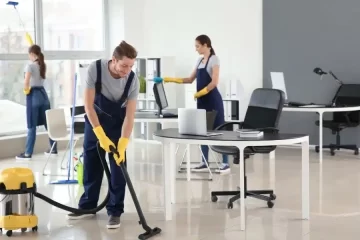How to Make a Modern Deer Fence for Your Garden

Anyone who has a garden knows how frustrating it is to work day in and day out only to find that deer have eaten your tomatoes, nibbled on the squash and peas or ripped the bark off the trees.
Certainly, we’ve tried all sorts of methods to deter the deer, from human hair to Irish Spring soap, but to no avail.
After much research we decided that the best method would be to install a deer fence to enclose the garden.
When you garden in deer country, growing vegetables can be a real challenge.
To keep out high-jumping deer, many gardeners surround their crops with tall fences that have the look of a maximum-security prison.
However we wanted to keep our beautiful views as well as look good from the street.
Not only did it turn out beautiful, but we have succeeded in keeping the deer out of our vegetable garden!
Keep on scrolling for all the details for constructing your own deer fence.
Building a Deer-Proof Garden Fence: A Step-by-Step Guide
Anyone who has faced the exasperation of finding their garden ravaged by deer understands the critical need for a dependable deer fence. The impact of deer damage on garden crops can be discouraging, prompting the necessity for a robust and aesthetically pleasing barrier. In this comprehensive guide, we’ll delve into the step-by-step process of constructing deer fences that not only effectively wards off deer but also stands the test of time. By utilizing sturdy materials like pressure-treated posts, concrete, and galvanized hog wire panels, combined with essential tools such as drills, saws, and levels, you can embark on building a formidable fence that safeguards your garden with style. Proper planning, precise measurements, and meticulous installation of posts, footer, and top rail boards ensure structural integrity, while the addition of a trellis adds both height and visual appeal. This guide empowers gardeners to protect their hard work and enjoy a flourishing garden free from the persistent threat of deer intrusion.
Why Build a Deer Fence?
Gardening in regions where deer are common presents unique challenges due to the persistent threat of damage to crops and plants. Deer are capable of effortlessly leaping over low fences, emphasizing the necessity for a tall and resilient barrier to effectively safeguard your garden. To address this challenge, it’s crucial to understand the materials required and follow a detailed step-by-step process for constructing a deer fence that offers reliable protection. By utilizing materials like pressure-treated posts, concrete for stability, and galvanized hog wire panels, coupled with essential tools such as drills, saws, and levels, you can embark on building a formidable fence that deters deer effectively. Proper planning, accurate measurements, and careful installation ensure the creation of a sturdy fence that preserves the integrity of your garden and allows for a thriving growing environment free from deer interference.
Materials You’ll Need:
To start building your deer fence, gather the following materials:
- 4x4x10 pressure-treated posts
- Concrete
- 2×4 pressure-treated lumber
- Galvanized hog wire panels
- 2×6 pressure-treated lumber
- 2×2 boards
- Deck screws
- Drill
- Saw
- Angle grinder
- Level
- Distance laser meter
Determining Fence Measurements
To embark on constructing an effective deer fence, start by meticulously planning the length and layout of your fence. Begin by measuring the perimeter of your garden to accurately determine the linear feet of fencing needed. This measurement will guide you in calculating the quantity of materials required for the project. Additionally, consider the strategic placement of gates within the fence layout to ensure convenient access to your garden space for maintenance and harvesting. It’s essential to account for the number of posts needed based on the length of your fence to provide adequate support and stability. Proper planning at this stage sets the foundation for a successful deer fence installation, enabling you to create a robust barrier that effectively protects your garden from deer intrusion while maintaining accessibility and functionality.
Installing the Posts
To begin the installation of your deer fence, utilize a post hole digger to excavate holes approximately 2 feet deep for each post along the planned perimeter. Carefully position the posts within these holes and secure them in place by filling the holes with concrete. This ensures stability and durability, especially in areas prone to inclement weather or wildlife pressure. To maintain a straight and uniform alignment for your fence, run a taut string from one end to the other along each side of the fence layout. Align each post carefully with the string, ensuring consistent spacing and vertical positioning. This meticulous approach guarantees the structural integrity of your deer fence, laying the groundwork for a sturdy and effective barrier against deer intrusion while enhancing the overall aesthetics of your garden landscape.
Attaching Footer and Top Rail
After allowing the posts to set and the concrete to fully cure, proceed with installing the footer and top rail boards to frame your deer fence. Begin by cutting the 2×4 boards to the required lengths based on the distance between each post. Attach these boards horizontally to the posts using screws or brackets, ensuring a secure fit. Position the footer board approximately 9 inches above the ground level to provide stability and prevent direct contact with soil or moisture. For the top rail board, install it at the desired height, typically around 60 inches above the ground, to establish the overall height of the fence. This step not only reinforces the structural integrity of the fence but also serves as the foundation for attaching the fencing material, ensuring a well-constructed and visually appealing barrier that effectively deters deer from accessing your garden.
Installing Hog Panels
To effectively enclose each section of your deer fence, use 2×4 boards to create frames for the hog wire panels. Begin by attaching these boards horizontally to the footer and top rail of the fence, leaving sufficient space between them to accommodate the hog wire panels. Ensure the boards are securely fastened to provide a sturdy framework. Next, cut the hog wire panels to size using an angle grinder, ensuring they fit snugly within the frames. Position the hog wire panels within the frames and secure them in place using deck screws. This method not only strengthens the overall structure of the fence but also provides a durable and visually appealing barrier that effectively prevents deer from entering your garden area. The combination of sturdy framing and hog wire panels ensures optimal security and protection for your plants and crops against deer intrusion.
Adding a Trellis
To enhance both the height and visual appeal of your deer fence, consider installing a trellis on top. Begin by attaching 2×6 boards vertically on each side of the fence posts to form a sturdy trellis frame. Use a jigsaw to craft decorative arcs or patterns on the boards, elevating the aesthetic appeal of the trellis. This creative touch adds a personalized and attractive element to your garden fence. Once the trellis frame is in place, secure 2×2 boards horizontally across the top to complete the structure. This horizontal arrangement provides support for climbing plants and vines, allowing them to flourish vertically while adding beauty and dimension to your garden landscape. The trellis not only serves a functional purpose by increasing the fence height but also enhances the overall visual appeal of your outdoor space, creating a charming and inviting atmosphere for both gardeners and visitors.
Final Touches
After completing the construction of your deer fence, take the time to thoroughly inspect all components to ensure they are securely fastened and aligned properly. This meticulous inspection is essential for confirming the structural integrity of the fence and its ability to withstand external pressures, including potential deer activity. Additionally, consider applying a protective stain or treatment to the wood, especially if using materials like cedar or redwood, to enhance durability and longevity against weather elements. This preventive measure helps preserve the fence’s appearance and functionality over time. Finally, take a moment to admire your newly constructed deer fence, appreciating the hard work and attention to detail that went into its creation. With the fence in place, you can feel confident that your garden is well-protected and visually enhanced, creating a harmonious outdoor space where plants can thrive undisturbed by deer and where you can fully enjoy the beauty of your garden landscape.










